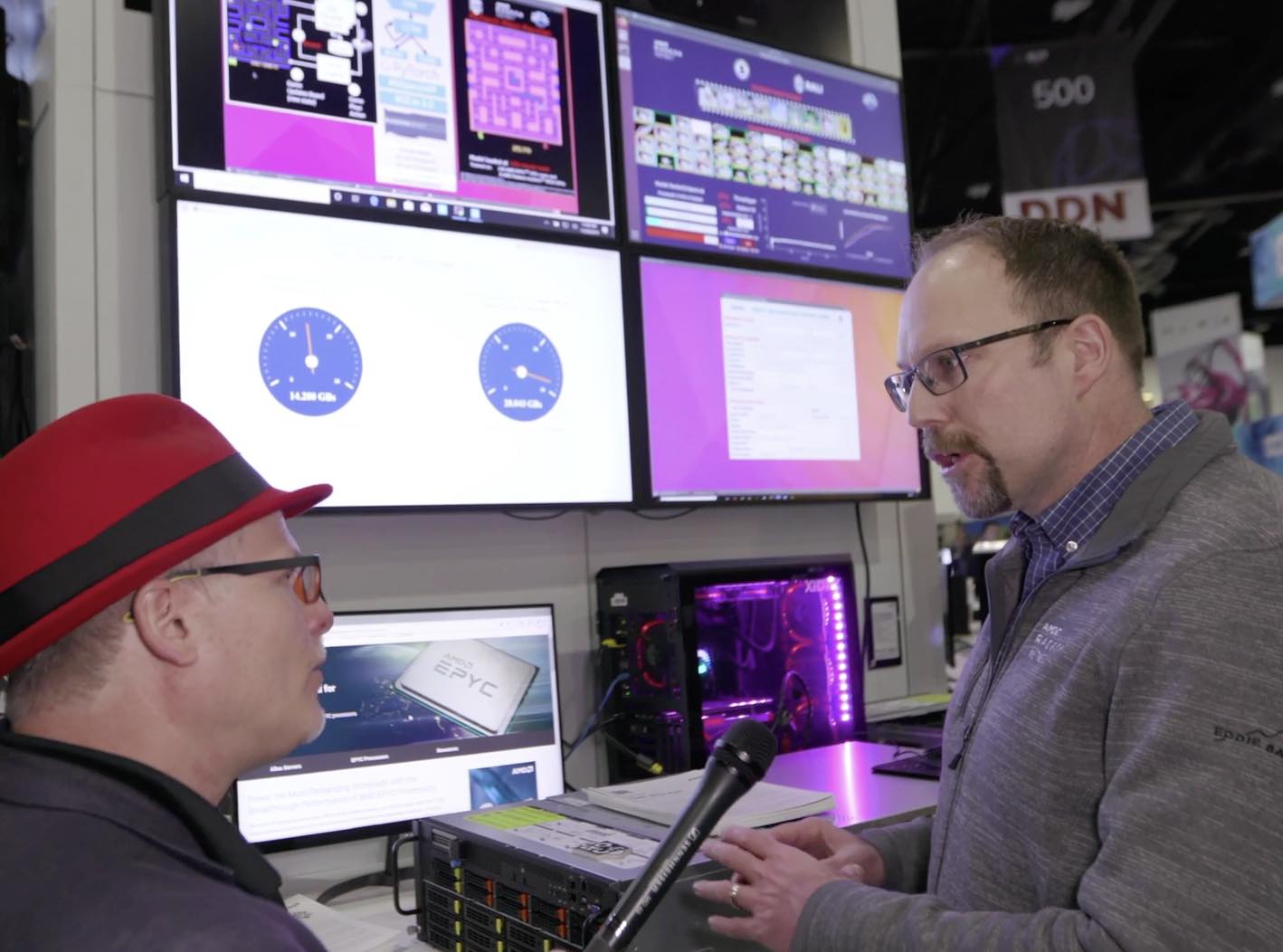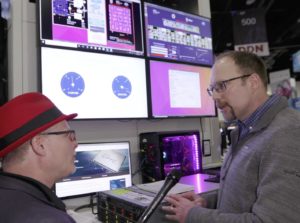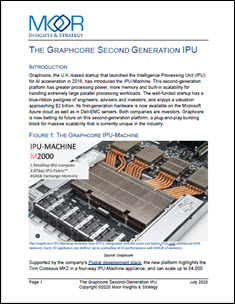In this video from SC19, Derek Bouius from AMD describes how the company’s new EPYC processors and Radeon GPUs can speed HPC and Ai applications. With its EPYC processors, Radeon Instinct accelerators, Infinity Fabric technologies, and ROCm open software, AMD is building an Exascale ecosystem for heterogeneous compute.
AMD enters SC19 as the processor provider for the upcoming Frontier supercomputer, expected to be the highest performance supercomputer in the world when it is delivered in 2021,” said Mark Papermaster, executive vice president and chief technology officer, AMD. “Show attendees can spend time with the same foundational AMD technologies that will go into that exascale-class system this week. From high performance AMD EPYC CPUs and Radeon Instinct GPUs working together across high-speed interconnects, to our open software ecosystem, all delivered by the biggest names in supercomputing, it’s all here at SC19.”
At SC19, AMD announced a set of new customer wins and new platforms supporting AMD EPYC processors and Radeon Instinct accelerators, as well as the release of ROCm 3.0 development environment.
AMD Introduces ROCm 3.0
Community support for the pre-exascale software ecosystem continues to grow. This ecosystem is built on ROCm, the foundational open source components for GPU compute provided by AMD. The ROCm development cycle features monthly releases offering developers a regular cadence of continuous improvements and updates to compilers, libraries, profilers, debuggers and system management tools. Major development milestones featured at SC19 include:
- Introduction of ROCm 3.0 with new innovations to support HIP-clang – a compiler built upon LLVM, improved CUDA conversion capability with hipify-clang, library optimizations for both HPC and ML.
- ROCm upstream integration into leading TensorFlow and PyTorch machine learning frameworks for applications like reinforcement learning, autonomous driving, and image and video detection.
- Expanded acceleration support for HPC programing models and applications like OpenMP programing, LAMMPS, and NAMD.
- New support for system and workload deployment tools like Kubernetes, Singularity, SLURM, TAU and others.
AMD Powers Supercomputers to New Levels and EPYC Joins TOP500
HPC organizations are continuing to adopt the 2nd Gen AMD EPYC processor and Radeon Instinct accelerators for more powerful and efficient supercomputing systems. The 2nd Gen EPYC processors provide twice the manufacturing application performance and up to 60% faster Life Sciences simulations than competing solutions, while the Radeon Instinct GPU accelerator provides up to 6.6 peak theoretical TFLOPS Double Precision performance for HPC workloads. Both products support PCIe® 4.0 enabling high-bandwidth interconnect for faster compute across heterogenous systems.
The latest customers deploying AMD processors and accelerators include:
- Atos, a global leader in digital transformation, is supplying two BullSequana XH2000 supercomputers based on 2nd Gen EPYC to Météo-France for operational weather forecasting and research in atmospheric, ocean and climate science.
- Atos and GENCI announced that the latest extension of its Joliot-Curie supercomputer, located and administered by the CEA teams at its TGCC (Very Large Computing Centre), and based on Atos’ BullSequana XH2000 solution and 2nd Gen EPYC is now operational.
The extension of the Joliot-Curie supercomputer joined the 54th edition of the TOP500, making it the first AMD EPYC 7H12 64-core 280W equipped supercomputer in the global ranking. - Cray, a Hewlett Packard Enterprise company, recently announced two new supercomputers equipped with the 2nd Gen AMD EPYC processors and based on the Shasta supercomputer architecture, ARCHER2 and Vulcan.
- Dell Technologies is supplying the San Diego Supercomputer Center and its Expanse supercomputer with Dell EMC PowerEdge servers and 2nd Gen EPYC Processors.
ETH Zurich is using AMD EPYC 7742 processors in its Euler VI system. - NEC is supplying the German weather forecasting service, Deutscher Wetterdienst, a system using 2nd Gen EPYC processors in conjunction with NEC SX-Aurora TSUBASA vector engines.
We chose the AMD EPYC 7742 because the processor not only provided broad support for most common software applications our researchers use, but it provides the raw performance, impressive memory and I/O bandwidth and most importantly the price/performance that is critical to meeting the demands of these researchers,” said Christian Bolliger, scientific IT services, ETH Zurich. “With the Euler VI system using 2nd Gen AMD EPYC processors, our users now have access to a system that will provide them the capabilities needed to advance their research.”
Bringing Supercomputing to the Cloud with AMD EPYC
The HPC industry is evolving to support new workloads, greater demands for performance and most importantly, easier access for long term or temporary use. This is being done through the Cloud, which for the first time can provide users with the same levels of performance, at lower use costs, compared to what they can deploy on-premise:
- AWS is expanding its use of AMD EPYC processors, announcing the upcoming launch of two new Amazon Elastic Compute Cloud (Amazon EC2) compute-optimized instances. These instances, C5a and C5ad, will be powered by custom 2nd Gen AMD EPYC processors, running at frequencies up to 3.3Ghz. C5a and C5ad will come in 8 virtualized sizes with up to 96 vCPUs which will provide additional choices to help customers optimize both cost and performance for a variety of compute intensive workloads, including batch processing, distributed analytics, and web applications. Both instances will be available in bare metal variants which will enable customers to run applications that benefit from direct access to the processor and memory resources of the underlying server. These instances will have 192 logical processors on 96 physical cores, which will be twice the largest instance size offered in the EC2 compute-optimized instance family. The C5a and C5ad bare metal instance will be able to utilize 100 Gbps network bandwidth and will be compatible with Elastic Fabric Adapter, enabling customers to scale up High Performance Computing and other large compute intensive workloads. The new instances will be available soon across multiple AWS regions.
- Microsoft Azure recently announced previously unobtainable levels of performance for computational fluid dynamics (CFD) using an Azure HB cloud instance running on an 1st Gen AMD EPYC-processor based system. Now, Azure is pushing the boundaries of HPC in the cloud even further with the preview of Azure HBv2 virtual machines for high-performance computing. Based on the AMD EPYC 7742 processor, these virtual machines provide customers with access to supercomputer performance, supporting 200Gbps HDR InfiniBand, and up to 80,000 cores for a single job, in the ease and simplicity through the Cloud.





